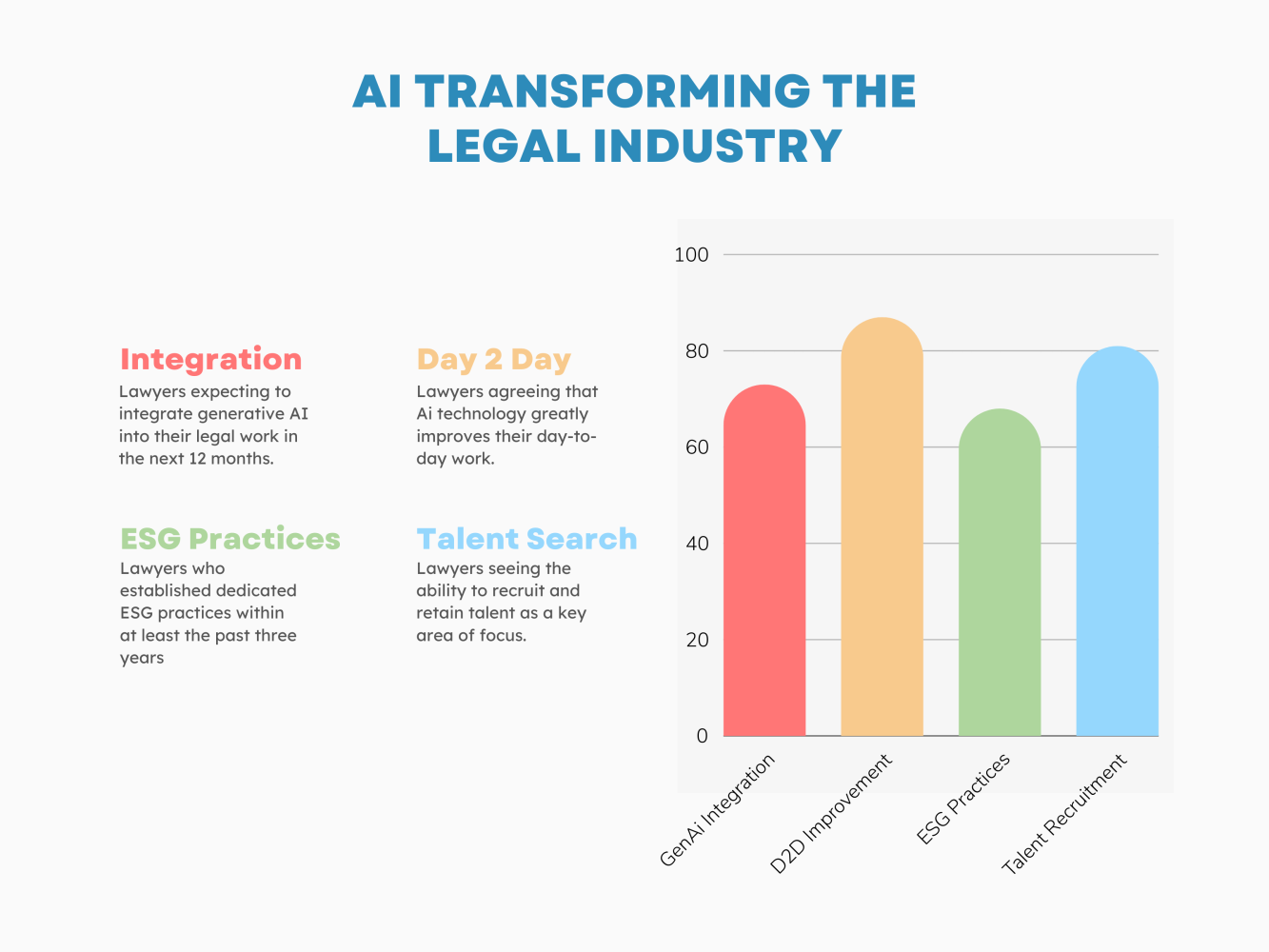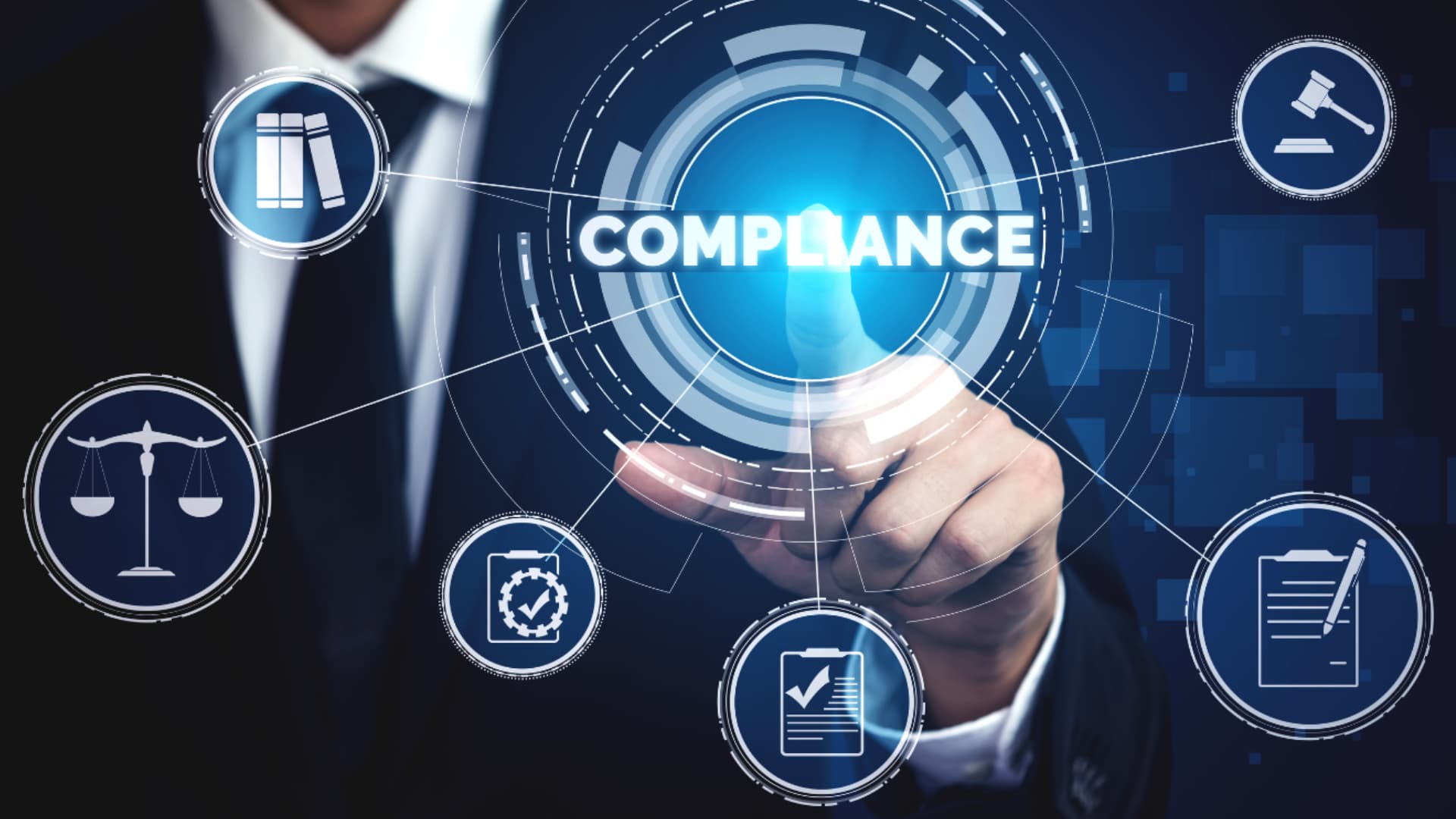AI for legal compliance and risk management is revolutionizing the way organizations navigate complex regulatory landscapes and mitigate potential risks. By using artificial intelligence, companies can:
● Improve efficiency
● Enhance compliance posture
● Enable proactive risk management

The infographic underscores the growing reliance on AI to enhance efficiency, compliance, and talent management in the legal sector. For more details, visit the survey.
In this series of articles, we will explore 10 ways in which AI is transforming the field of legal compliance and risk management, and discuss the associated benefits and challenges.
As we explore specific use cases where AI is transforming various aspects of legal compliance and risk management, we will highlight:
- How AI can bring significant benefits.
- The unique challenges that need to be addressed.
Let’s dive in!
1. Enhancing Efficiency and Effectiveness Through Automated Contract Analysis
Artificial intelligence (AI) has completely transformed how organizations handle contract analysis, making it more efficient and effective. This is especially true when it comes to legal compliance and risk management. Thanks to natural language processing (NLP) algorithms, the contract review process can now be streamlined, and potential risks can be identified earlier.
How AI-Powered Contract Analysis Works
AI, specifically NLP algorithms, allows organizations to automate the extraction and analysis of key information from contracts. Here’s an overview of how it works:
1. Automated Extraction: AI algorithms can quickly identify and extract important terms, clauses, and obligations from contracts.
2. Analysis and Comparison: Once the relevant information is extracted, AI systems can analyze and compare it against predefined criteria or standards.
3. Risk Identification: By analyzing the extracted data, AI systems can identify potential risks or issues within contracts.
This automated approach significantly reduces the time and effort required for manual review processes, enabling legal teams to focus on more strategic tasks.
Example Use Cases
Many organizations across different industries have already embraced AI-powered solutions for contract analysis. Here are two examples:
1. Data Privacy Compliance: A multinational corporation implemented an AI platform capable of extracting and categorizing contractual provisions related to data privacy regulations. This allowed the organization to ensure compliance with evolving data protection laws while minimizing manual errors.
2. Vendor Contract Management: An e-commerce company utilized AI technology to streamline its vendor contract management process. The system automatically extracted key terms such as pricing, delivery timelines, and termination clauses, making it easier for the company to negotiate favorable agreements.
These examples demonstrate how AI can be applied to specific use cases within contract analysis, bringing significant benefits in terms of time savings and risk mitigation.
Benefits of AI-Powered Contract Analysis
The adoption of AI in contract analysis offers several advantages for organizations:
1. Increased Efficiency: AI-driven contract analysis accelerates the review process, enabling legal teams to handle a larger volume of contracts within shorter timeframes.
2. Reduced Manual Errors: Automation minimizes the likelihood of human errors associated with manual contract review, enhancing overall accuracy in risk assessment and compliance evaluations.
Challenges in Implementing AI for Contract Analysis
While there are clear benefits to using AI in contract analysis, there are also some challenges that need to be addressed:
1. Ensuring Accuracy in Complex Legal Interpretations: While AI, particularly the promising GPT-4O, significantly enhances contract analysis, ensuring precise interpretations of complex legal language remains a challenge. Legal nuances and contextual understanding pose ongoing hurdles for AI systems. Although GPT-4O shows potential to outperform its predecessors in legal research, it has not yet been sufficiently analyzed to fully understand its capabilities and limitations.
2. Addressing Biases in Training Data: The reliance on historical data for training AI models introduces the risk of perpetuating biases present in the source data. Mitigating these biases requires careful curation of training datasets and continuous model validation. Organizations must remain vigilant in identifying and correcting biases to ensure fair and unbiased contract analysis outcomes.
It’s important for organizations to be aware of these challenges and implement appropriate measures to mitigate them. The evolution of AI, exemplified by GPT-4O, shows promising improvements for legal research and contract analysis, but ongoing efforts are necessary to refine these systems further.
Recommended Resource: A recent episode of the “AI Lawyer Talking Tech” podcast delves into how AI is transforming contract drafting in the legal industry. The discussion covers how AI tools automate repetitive tasks, enhance accuracy with machine learning and natural language processing, and ensure compliance by monitoring legal updates. This podcast provides an in-depth look at the significant benefits of AI in legal workflows.
AI’s role in automated contract analysis continues to evolve as organizations seek to harness its capabilities for more robust risk management strategies. In the next sections, we will explore additional ways in which AI is transforming legal compliance and risk management practices.
2. Improving Compliance Posture with Intelligent Regulatory Monitoring
AI-driven tools offer real-time tracking and analysis of regulatory changes, enabling organizations to identify potential compliance gaps. For example, a company successfully avoided non-compliance issues through the use of an intelligent monitoring system. The benefits of intelligent regulatory monitoring include proactive compliance management and reduced regulatory risks. However, challenges such as dealing with information overload and maintaining data privacy must be addressed.
How Intelligent Regulatory Monitoring Works
Intelligent regulatory monitoring tools leverage AI to provide real-time updates on regulatory changes, helping organizations stay abreast of evolving compliance requirements. By automating the process of tracking and analyzing regulatory updates, these tools enable early identification of potential compliance gaps, allowing companies to take proactive measures to address them.
Real-Life Example: Multinational Financial Institution
For instance, a multinational financial institution utilized AI-powered regulatory monitoring to identify a critical update in tax regulations that had the potential to impact their operations in multiple countries. By promptly addressing this change, the organization was able to avoid non-compliance issues and mitigate associated risks.
The Benefits of Intelligent Regulatory Monitoring
The proactive nature of intelligent regulatory monitoring empowers organizations to maintain a strong compliance posture by staying ahead of regulatory developments. This approach not only helps in avoiding penalties resulting from non-compliance but also contributes to building a culture of adherence to ethical and legal standards within the organization.
Challenges in Implementing Intelligent Regulatory Monitoring
Despite these clear benefits, organizations face challenges when implementing intelligent regulatory monitoring systems:
1. Information Overload: The volume and velocity of regulatory updates can lead to information overload, making it challenging for compliance teams to sift through the deluge of data and extract actionable insights.
2. Data Privacy: Ensuring data privacy while collecting and analyzing vast amounts of regulatory information poses a significant challenge that requires careful consideration.
It is important for organizations to address these challenges in order to successfully implement and derive sustainable benefits from these AI-driven solutions.
